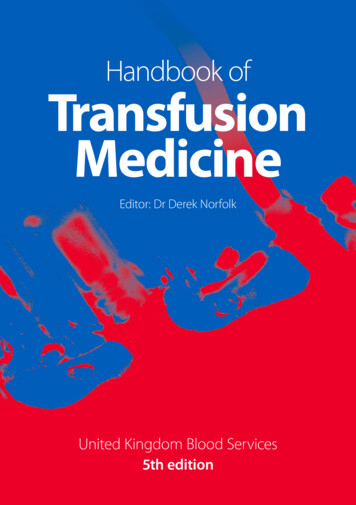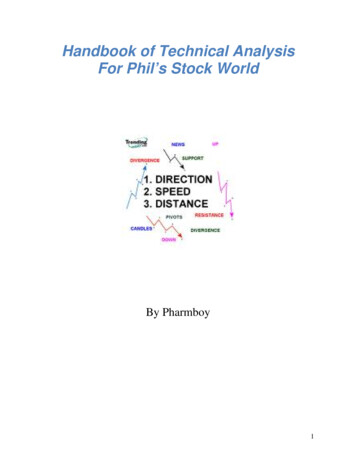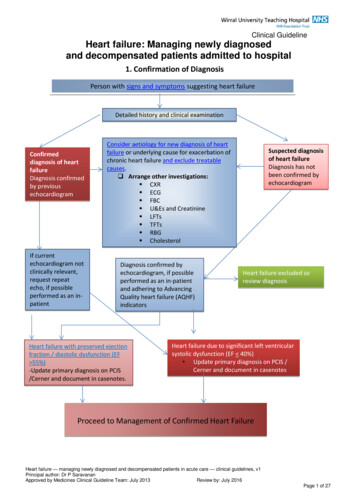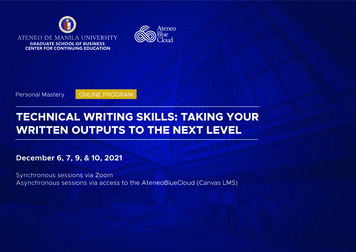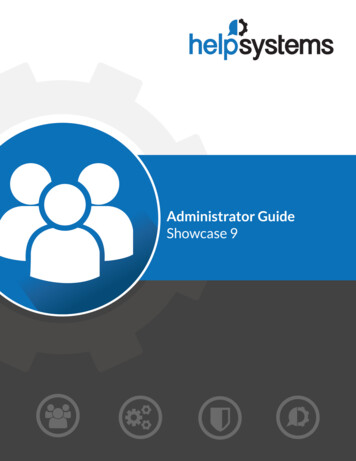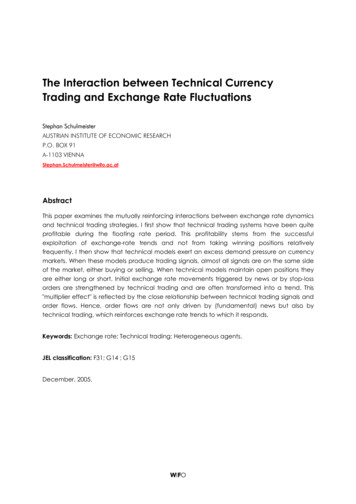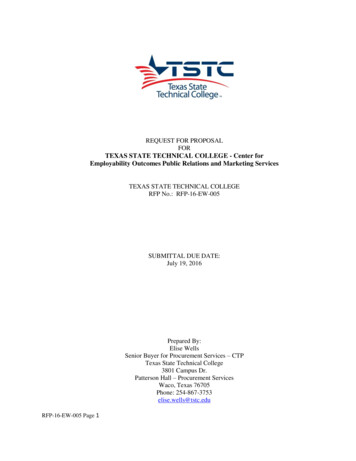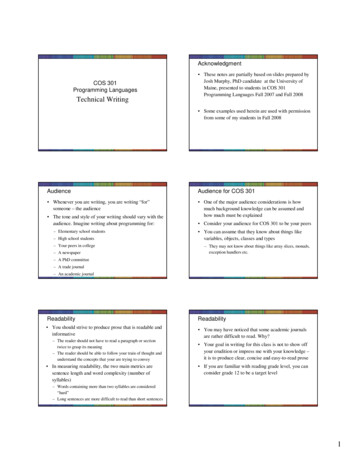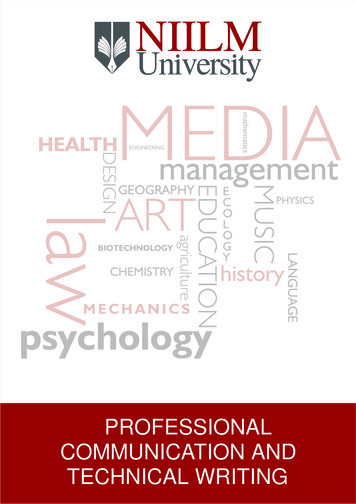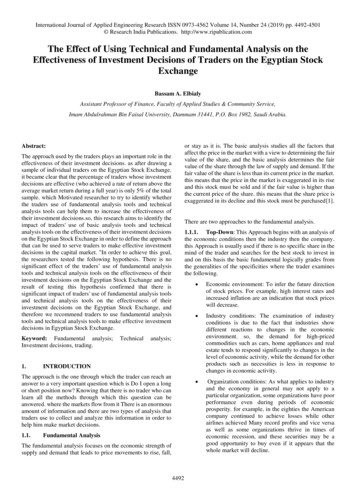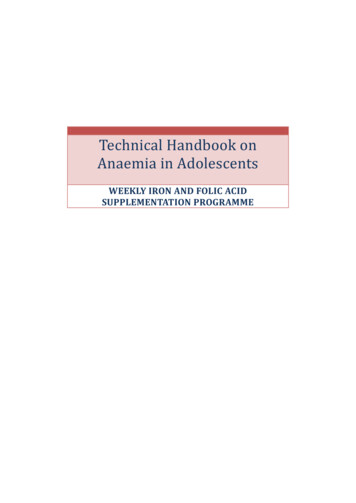
Transcription
Technical Handbook onAnaemia in AdolescentsWEEKLY IRON AND FOLIC ACIDSUPPLEMENTATION PROGRAMME
I.IRON AND ANAEMIAAnaemia is a critical public health problem in India that affects women and childrenthroughout the lifecycle. Anaemia in boys and girls limits their development, learningability, reduces concentration in daily tasks, increases their vulnerability to infection,increases school dropout rates, reduces physical fitness and work productivity.Anaemia in girls during pregnancy is associated with premature births, low birthweight, and peri-natal and maternal mortality.Adolescence is an opportune time for interventions to address anaemia, as it is animportant time of growth and development. Missing out on nutrition education and IFAsupplementation at this time may push young boys and girls further into the cycle ofiron deficiency and anaemia. In adolescent girls, apart from meeting growth needs,sufficient iron intake is also essential before and during pregnancy.What is Iron?Iron is one of the essential nutrient required by our body , as it cannot madeby ourbody on its own. Iron is so important to your body that is has been referred to as thebody’s gold. Most of the iron in your body is found as part of proteins called hemoglobin,which is found in red blood cells of blood. Hemoglobin in blood carries the oxygen youbreathe into your lungs to all tissues throughout the bodyCLOSER LOOK
What is anaemia?Human blood contains a red pigment called haemoglobin, which is rich in iron. It carriesoxygen to different parts of body. Deficiency of iron in diet leads to decreased amount ofhaemoglobin, making the blood thin and less red in colour which leads to less supply ofoxygen to different parts of the body; this state is known as anaemia.Cut off levels of hemoglobin for diagnosis of AnemiaAge/SexChildren 6 months to 6 yearsChildren 6 to 14 yearsHb Gram/dl1112Adolescents 15-19 years12Adult male13Adult female12Adult female pregnant11If the level falls below those above, then the person is diagnosed as having anaemia.Classification of anaemia according to WHOMild anaemiaModerate anaemiaSevere anaemiaAnaemia in non-pregnant womanAnaemia in pregnant womenII.11.9 gm to 10 gmHb /100 ml blood9.9 gm to 7gm Hb /100 ml blood 7 gmHb/100 ml blood 12 gmHb/100 ml blood (above 15 years ofage) 11 gmHb/100 ml bloodCAUSES AND EFFECTS OF ANAEMIAa) Common causes of anaemiaThere are many different types of anaemia. They could be nutritional or non -nutritionalcauses (heavy/chronic bleeding, infections, genetic disorders or cancers). Nutritionalanaemia, particularly, is the most widely prevalent form of anaemia in the country.Causes of Iron Deficiency Anemia and nutritional anaemia are: Poor Dietary intake of iron resulting in deficiency of iron in the body and thusIron deficiency anaemia (less intake of iron rich foods; Gender discrimination in foodallocation in a family aggravates the situation1
Low bio-availability of iron- Habitual intake of cereal based diet high in phytateand poor consumption of iron absorption enhancers such as vitamin C result inlow availability of ironDietary deficiency of vitamins such as Folic Acid, Vitamin C, Vitamin B12Non nutritional causes of anaemia: Accelerated increase in requirement for iron during adolescent period Hookworm infestation Infections such as Malaria Loss of blood in case of heavy menstrual bleeding. Teenage marriage and early pregnancy – Teenage pregnancy places doubleburden on the physically and physiologically immature body of girls and resultsin increasing the likelihood of anaemia, maternal mortality, pregnancycomplications and birth of low birth weight babies.Iron Deficiency and Iron Deficiency Anaemia – An Overview of CausesIron Deficiency and Iron Deficiency AnaemiaInadequate dietary intakeagainst very highrequirement Low content of iron,lowintakeofenhancers HighintakeofinhibitorsIntestinal worm infestationInadequate care ofadolescent girls, menstrualloss, early onsetconception.Lack of access tohealthservices,clean water : Vir, Sheila, (2011) Public Health Nutrition in Developing CountriesIron deficiency anaemia develops after normal stores of iron have been depleted in thebody. Thus the signs of anaemia may not be clinically visible until the anaemia is severe(Hb less than 7-8 gms/dl).1 However, adverse impact on health occurs even before thisstage is reached.b) Who is affected?The high risk groups for anaemia include Women of child bearing age who have blood loss through menstruation1Nelson Textbook of Pediatrics; Volume 1 Chapter Anemia Treatment and Causes2
Pregnant and lactating women who have an increased requirement of iron Adolescents and children who have rapid growth phases People with poor dietary intake of iron through a deficient diet.Intergenerational cycle of Anemia - An adolescent girl who enters the reproductiveage with low iron stores and becomes pregnant during adolescence or later is at greaterrisk of giving birth to a low birth weight and preterm baby. The baby is also born withlow iron stores and due to poor infant feeding practices is more likely than ever to enteradolescence with low iron stores in the body. Thus this vicious cycle of iron deficiencyanemia continues.Intergenerational cycle of AnemiaAdolescent entersreproductive agegroup with low ironstores.Adolescent with lowiron and Hb level Menstrual bloodlossUncorrectedanaemia in infancyand childhoodPregnant womanwith anaemiaBaby with low ironand haemoglobinlevelsWomen in general are more prone to anaemia than men because of smaller stores ofiron and the onset of menstruation imposes additional requirement of Iron tocompensate for menstrual blood loss. In Indian girls, the highest prevalence of anaemiais reported between the ages of 12-13 years which also coincides with the average ageof menarche. In girls, the lower total food intake or energy intake by compared to boys,combined with menstrual losses cause adolescent girls to be at greater risk of Irondeficiency and IDAc) Signs and Symptoms of anaemia:Definitive diagnosis of anaemia can only be made by a blood test that measuresHaemoglobin(Hb) levels in the blood.The test for Hb is carried out in health centres.However there are some signs that may assist in identifying anaemia. They include: Whiteness or pallor in the inner rims of the eyelid, tongue, overall skin, nails, palmsof the hand.3
I.PALLOR OF PALMSII. PALLOR OF NAIL BEDIII. PALLOR OF INNER RIM OFEYELIDS Soreness of the mouth, with cracks at the corners.Dizziness, tiredness, fatigue and low energyUnusually rapid heartbeat, particularly with exerciseShortness of breath and frequent headaches, particularly with exerciseLack of interest in play and studiesDifficulty/ inability to concentrateLeg crampsLowered resistance to infectionsIron deficiency anemia develops after normal stores of iron have been depleted in thebody. Thus the signs of anemia may not be clinically visible until the anemia is severe(Hb less than 7-8 gms/dl).2 However, adverse impact on health occurs even before thisstage is reached.2Nelson Textbook of Pediatrics; Volume 1 Chapter Anemia Treatment and Causes4
d) How to identify anemia:Pallor is unusual paleness of the skin. It is a sign of anaemia.1. Palmar pallor- To see if the child has palmar pallor, look at the skin of the palm.Hold the child’s palm open by grasping it gently from the side. Do not stretch thefingers backwards. This may cause pallor by blocking the blood supply. Comparethe colour of the child’s palm with your own palm and with the palms of otherchildren. If the skin of the palm is pale, the child has some palmar pallor. If theskin of the palm is very pale or so pale that it looks white, the child has severepalmar pallor. Refer to Image I2. Nail bed pallor- Look for pallor of the flesh underneath the nails. Pallor of tongue,nail, conjunctiva (lower eyelids) of eyes, fatigue, weakness, dizziness,drowsiness, loss of appetite and swelling (odema) of feet. refer to Image II Pallor of inner side of lower eyelid- pull the lower eyelid downwards andoutwards and look for pallor or whiteness of inner side of lower eyelid Pallor of tongue- asks the child to protrude his/her tongue out and look forpaleness of surface of tongue. Refer to Image III If an adolescent looks pale, fatigued or listless and anemia is suspected, referher/him to the nearest PHC. ask for symptoms of weakness, dizziness, drowsiness, loss of appetite, cravingfor mud/clay, passage of worms in stool, loss of concentration.Moderate to severe anemia is present if there is: Yellowness of tongue, nail, palm and conjunctiva of eye Fatigue and loss of appetite Breathlessness Swelling (oedema) of feet III Prevention and Control of Anaemia in AdolescentsPrimary prevention of anaemia is achieved through well- balanced diet rich in iron andother vitamins and minerals involved in iron absorption or in the production ofRBCs/Haemoglobin.a) Balanced diet rich in IronAdolescence is a significant period for physical growth and sexual maturation.Adolescents need to eat a balanced diet i.e. a diet that provides all nutrients(carbohydrates, proteins, fats, vitamins and minerals) in required amounts andproportions for maintaining health and general well-being.Eating a balanced diet means consuming different types of food items like pulses,chapatti or rice, green vegetables, locally available fruits and milk every day.5
Functions of various food components and why it is important for adolescents: Proteins are required for body building and help in repair and maintenance ofbody tissues. Egg, milk, pulses, fish, meat, ground nut are some examples of bodybuilding foods.Fats are high-energy foods and provide fat-soluble vitamins. Oil, ghee, butter,cheese, egg, fat of meat, fish, ground nut oil, and mustard oil are some examplesof fat.Carbohydrates form the major component of most diets and are the main sourceof energy. Rice, potato, sugar, banana, jaggery, sugarcane, honey are theexamples.Vitamins and minerals are required in small quantities. They play an importantrole in growth, repair and regulation of vital body functions. Fruits andvegetables are the examples of protective food.Calcium needs during adolescence is greater in adolescence because of rapidincrease in lean body mass and skeletal growth. Milk and milk products are richsource of calcium.Foods rich in iron are(i)Green vegetables and fruits(ii)Grains-wheat, jowar, bajra, sprouted pulses, ground nut, sesame, jaggery,dried fruits(iii) Liver, egg, fish,meat(iv) Vitamin C rich foods help in absorption of iron. Citrus fruits (oranges, lemon),Indian gooseberry (Amla), apple, pear are rich in vitamin C.IRON RICH COMMOM FOODSHowever given that many of these sources of iron are often not available on aregular basis to most people in our country, eating green vegetables should beemphasized. This is more likely to be widely available even among families with lowincomes. It should certainly be part of the meals served in schools and at the AnganwadiCenters.In our Indian diets, the absorption of iron from the diet is poor because of thepresence of certain chemical substances. For example tannin in tea can hamper theabsorption of iron. On the other hand vitamin C and vitamin C rich foods like amla6
(Indian gooseberry, lime juice, oranges, and sprouts) improve iron absorption. Thus tea,coffee or soda containing drinks should not be consumed immediately before or at leasttwo hours after a meal. Adding Vitamin C rich foods to the meal should be encouraged.Vitamin Rich food like- AMLAb) Iron Supplementation:In India, the poor absorption of iron and a predominantly vegetarian diet means thatdespite the consumption of a balanced diet, iron supplementation is required toprevent and control anaemia. Anaemia among adolescents can be prevented byregular consumption of iron and folic acid tablets once a week, ideally 52 tablets in ayear. This is the basis of the WIFS programme launched by the Ministry of Health andFamily Welfare- Government of India has the Weekly Iron and Folic AcidSupplementation (WIFS). This programme addresses nutritional anaemia amongadolescents (age group of 10-19 years). This programme will be implemented panIndia both rural and urban areas. It will focus on:School Based (Boys and Girls)A. School going adolescent girls and boys in government/governmentaided/municipal schools from Classes 6th -12thCommunity Based through the Anganwadi Center(Girls only)B. Out of school adolescent girlsThe WIFS programme will also cover married adolescent girls. Pregnant andlactating adolescent girls will be given IFA supplements, according to currentguidelines for antenatal and postnatal care through the existing health system ofNRHM.Under the WIFS programme for adolescents, IFA supplements are to be distributedfree on a weekly basis to the target groups in Categories A and B. In addition to IFAsupplements, Albendazole tablets for de-worming are to be administered twice ayear, to the same target groups. Administration of weekly iron-folic acid supplements (WIFS).One IFA tabletcontaining 100mg elemental iron and 500 microgram Folic acid administered ona fixed day through supervised consumption for 52 weeks in a year.7
Screening of target groups for moderate/severe anaemia and referringthese cases to an appropriate health facility.Biannual Albendazole (400mg) for de-worming given six months apart, forcontrol of worm infestation.Information and counseling for improving dietary intake and for taking actionsfor prevention of intestinal worm infestation.c) Prevention and treatment of hookworm infestation: Deworming reduces wormload and blood loss and prevents anemia.To prevent hookworm infestation one should maintain personal hygiene andenvironmental cleanliness. One should use latrine and avoid open air defecation.Regular consumption of Albendazole 400mg tablet, six months apart, for controlof helminthes infestation should be undertaken. Personal hygiene and sanitation, food hygiene Use of clean drinking water can help protect from various infections anddiseases. Washing hands with soap water before cooking, consuming food, afterdefecation and after discarding faecal matter of a child is essential toprevent entry of germs into our abdomen Keeping personal hygiene Preparing and consuming hygienically treated or prepared foodd) Additional Interventionsi.Fortification of food with iron (salt, flour, rice, biscuits etc.)ii.Prevention of malaria: Clean surroundings, use of insecticide treatedmosquito net while sleeping helps keep malaria mosquitoes away frompeople and greatly reduces malariaiii.Early Identification and Referral- Early identification and referral of suspectedcases of anaemia constitutes an important measure of secondary preventionof anaemia.If anaemia is suspected it is important to refer the adolescent girl/boy to thenearest health facility for further management.8
COMMOM IRON RICH FOODSCHANA FENUGREEKLEAVES( METHI)MINTARVI KASAG9
LENTILBENGALGRAM,WHOLESOYABEANGINGELLYSEEDS ( TIL)RED GRAMDHAL (ARHAR)PLANTAINGREEN( UNRIPEKELA)BLACK GRAM,DHAL (URDDAL ORKASKALAY)MELON,WATER10
SEETHAPHALMUTTONCOMMOM VITAMIN C RICH FOODSCABBAGEDRUMSTICKLEAVESCORIANDERLEAVESAMLA11
SAMPLE ADOLESCENT BALANCED DIET10 – 12 years Adolescents BoysEarly morning : 1 glass milk (200 ml) 1 – 2 tsp sugarBreakfast: 2 vegetable stuffed parantha (any) /2 -3 dosas stuffed with potato vegetable / 2bread slices with butter / 4 idlis with coconut chutney/ 1 cup vegetable upma 1 cup tea (with1 – 2 tsp sugar)Mid-morning : 1 fruit like banana, apple, guava etc or 1 glass lemon juice (with 1 – 2 tsp sugar)Lunch : 4 rotis or 2 katori cooked rice or 2 rotis and 1 katori rice 1 katori green leafy vegetables (cooked in 1 tsp oil) 1 katori cooked dal or sprouts (cookedin 1 tsp oil) 1 katori dahi (200 ml) like aloo raita or carrot raita etcTea : 1 cup tea (with 1 – 2 tsp sugar) 1 rusk or 1 biscuit or aloo chaatDinner: 4 rotis or 2 katori rice or 2 roti and 1 katori rice 1 katori cooked dal/pulses vegetables (cooked in 1 tsp oil) 1 katori any vegetable (cookedin 1 tsp oil)10 – 12 years Adolescent girlMenuEarly morning : 1 glass milk (200 ml) 1 – 2 tsp sugarBreakfast: 2 vegetable stuffed parantha (any) /2 -3 dosas stuffed with potato vegetable / 2bread slices with butter / 4 idlis with coconut chutney/ 1 cup vegetable upma 1 cup tea (with1 – 2 tsp sugar)Mid-morning : 1 fruit like banana, apple, guava etcLunch : 3 rotis or 1 ½ katori cooked rice or 2 roti and ½ katori rice 1 katori any green leafy vegetables (cooked in 1 tsp oil) 1 katori any cooked dal or sprouts(cooked in 1 tsp oil) 1 katori dahi (200 ml) like aloo raita or carrot raita etcTea : 1 cup tea (with 1 – 2 tsp sugar) 1 rusk or 1 biscuit or aloo chatDinner: 3 rotis or 1 ½ katori rice or 1 roti and ½ katori rice 1 katori any cooked dal/pulses vegetables (cooked in 1 tsp oil) 1 katori any vegetable(cooked in 1 tsp oil)12
13 – 18 years Adolescent girlEarly morning : 1 glass milk (200 ml) 1 – 2 tsp sugarBreakfast: Breakfast: 2 vegetable stuffed parantha (any) /2 -3 dosas stuffed with potatovegetable / 2 bread slices with butter / 4 idlis with coconut chutney/ 1 cup vegetable upma 1cup tea (with 1 – 2 tsp sugar)Mid-morning : 1 fruit like banana, apple, guava etcLunch : 3 rotis or 1 ½ katori cooked rice or 2 rotis and ½ katori rice 1 katori green leafy vegetables (cooked in 1 tsp oil) 1 katori cooked dal or sprouts (cookedin 1 tsp oil) 1 katori dahi (200 ml) like aloo raita or carrot raita etc or 1 katori paneer sabjiTea : 1 cup tea with 1 – 2 tsp sugar) 2 rusk or 2 biscuit or ½ katori aloo chaatDinner: 3 rotis or 1 ½ katori rice or 2 roti and ½ katori rice 1 katori cooked dal/pulses vegetables (cooked in 1 tsp oil) 1 katori any vegetable (cooked in1 tsp oil)13 – 18 years Adolescent BoysEarly morning : 1 glass milk (200 ml) 1 – 2 tsp sugarBreakfast: 3 aloo ka parantha/ vegetable stuffed parantha (any) /3 rotis 1 katoripaneer sabji or aloo sabji/ 4 bread slices with butter /3-4 dosas stuffed with potatovegetable / 5-6 idlis with coconut chutney/ 2 cup vegetable upma 1 cup tea (with 1 –2 tsp sugar)Mid-morning : 1 fruit like banana, apple, guava etcLunch : 4 rotis or 1 ½ katori cooked rice or 2 rotis and ½ katori rice 1 katori green leafy vegetables (cooked in 1 tsp oil) 1 katori cooked dal or sprouts(cooked in 1 tsp oil) 1 katori dahi (200 ml) like aloo raita or carrot raita etc or 1 katoripaneer sabjiTea : 1 cup tea with 1 – 2 tsp sugar) 2 rusk or 2 biscuit or 1 katori aloo chaatDinner: 4 rotis or 1 ½ katori rice or 2 roti and ½ katori rice 1 katori cooked dal/pulses vegetables (cooked in 1 tsp oil) 1 katori any vegetable(cooked in 1 tsp oil)13
14
Fats are high-energy foods and provide fat-soluble vitamins. Oil, ghee, butter, cheese, egg, fat of meat, fish, ground nut oil, and mustard oil are some examples of fat. Carbohydrates form the major component of most diets and are the main source of energy. Rice,
